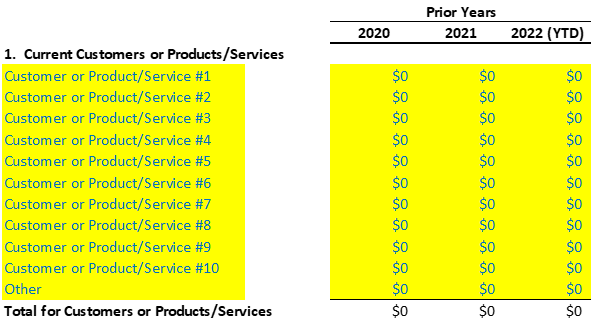Profit Plan vs. Budget: Creating A Profit Plan with Purpose

As a small business owner, chances are you’ve been told countless times how important it is to have a business plan or a budget for your small business. Budgets are the worst! Hopefully, you don’t use one for your business.
What you really need is a Profit Plan which shows how your business is going to make money on purpose over the next twelve months. A big reason we focus on Profits Plans and not budgets is that budgets usually miss a big item…your Sales Forecast! Budgets tend to focus only on expenses. Remember that you can increase your profits by increasing sales or reducing expenses.
As business coaches, we have worked with hundreds of small business owners over the decades and we’ve heard too many of them complain that they can’t forecast their sales. Don’t believe the hype! We contend that you can forecast sales for any business. Especially for one that’s been around for at least a couple of years.
But before you forecast your sales, you need to take a look at the history first so you can make a key decision. How would you like to categorize your sales? Does it make more sense to categorize your sales around your Products/Services or around your Top Customers/Target Markets?
Here are some questions to ponder to help you decide:
Products/Services
- How do you currently track your sales (Products/Services or Customer/Target Markets)?
- Which of your Products/Services are your top sellers?
- Which of your Products/Services are the most profitable?
- Are there other things you sell that can easily grow or that you should stop selling?
- When is the last time you introduced a new Product/Service?
Top Customers/Target Markets?
- Who are your customers (businesses, individuals, government)?
- Are your customers different depending on the type of Products/Services purchased?
- Who are your best customers/target markets in terms of sales $ as well as profitability?
- What percent of customers are repeat every year? How can you increase that?
- What other markets could you target?
- Do you prefer one type of customer over another (e.g. business vs. individual)?
- What do you know about your customers?
If you spend a few minutes batting around the above questions, chances are one of the categories will make more sense for you than the other. Start with that category first (i.e. either Products/Services or Top Customers/Target Markets) and see how it works to help you with organizing your historical sales first. This little bit of historical analysis will go a long way in helping you organize and forecast your sales going forward.
Start with compiling a list of your Top Customers/Target Markets or top selling Products/Services based on sales $ over the past 1-3 years. Try to account for at least 80% of the prior years’ sales. This can be pulled from your accounting software (e.g. QuickBooks) or you should be able to generate some reports from your POS system or whatever method you’ve historically been using to track your sales. You will then want to enter those Top Customers/Target Markets or top selling Products/Services into a spreadsheet like the one shown below to assist you in analyzing your historical sales:

After you’ve populated this spreadsheet you can sit back and see what the numbers are telling you. Having something like this not only gives you some insights into your overall sales but for each of the categories you have listed. For instance, you might notice that your overall sales are increasing but you might notice that the growth is only in one particular account. Or may you see that only a few of your Customers/Target Markets or Products/Services account for the majority of your sales? What you see here will help inform your sales forecast for next year.
To start your sales forecast, we suggest you pick a number for your sales goal for next year. For instance, your historical sales might show a steady increase from $350,000 in sales three years ago to nearly $500,000 this past year. So is your goal for next year going to be $500,000 or something higher or lower? Once you set your overall goal for sales then you’ll want to start filling in some of the details using our historical analysis above.
Here are some variables to consider when forecasting your sales:
- What trends do you see in the historical sales? Are they increasing, decreasing, or flat (overall or for one particular Customer/Target Market or Product/Service)?
- What are you planning to do with your pricing next year (increase, decrease, no change)?
- What about the volume of sales of your Products/Services (will you be selling more or fewer)?
- What about things that are out of your control (e.g. economy, technology, customer or vendor sells their business, global pandemic)
Use these questions to now help guide your forecast for each line item on your sales forecast. Some line items you might show increasing while others are decreasing or remaining relatively flat. If you are forecasting based on specific customers, this will be a great opportunity for you to reach out to those customers and ask them what their plans are for the next year so you can ensure you have the most up to date assumptions possible for your forecast.
Once you’ve filled in each of these line items, step back to see how much of your initial annual sales goal you can see. For instance, if you set your initial sales goal at $550,000, how much of that can be seen in the detailed line items? Can you see $350,000 or $400,000 of it? Next you’ll want to add some more detail to this forecast to show any Backlog or Quoted work you have outstanding.
Backlog is signed purchase orders in hand for work that has not yet been completed. On the Quoted work front you’ll want to account for any work you’ve Quoted that you’re likely to land in the next year. After you subtract these numbers from your original annual sales goal you will then see how much of a hole you have left in your forecast which will need to be filled by your marketing plan.
For example, let’s say you can see $350,000 in sales from your current Customer base and you have an additional $50,000 in Backlog/Quoted work. That means you can “see” $400,000 of your $550,000 sales forecast and you’ll need to come up with a Marketing Plan to find the other $150,000 in sales.
As we always reinforce for folks, your Profit Plan and Sales Forecast won’t be “right” but they’ll be the best guesses you have at this point. And those guesses and the plans that surround it are what will drive your activities over the next year to make this Profit Plan a reality.
This guest blog was created by Adam Sonnhalter and Jack Mencini of Maximum Value Partners, a firm providing business coaching and consulting for small businesses. Maximum Value Partners (MVP) does the heavy lifting of analyzing with you what is working or not working and then coach you to implement and engage the right resources to help your small business thrive. Along the way, you will be doing the work and MVP will be there 24/7 to coach you and chart your path to success.